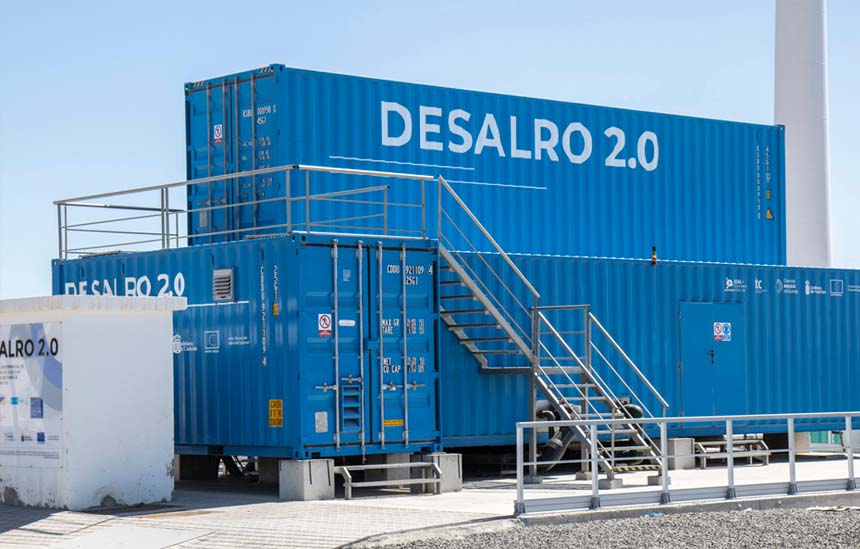When Spain’s DESAL+ LIVING LAB announced a new world record for SWRO energy efficiency this May, Danfoss high-pressure pumps were at the heart of the innovative solution. The breakthrough could have significant consequences for a thirsty world facing the combined threats of water scarcity and climate change.
Desalination is an increasingly critical source of drinking water for millions of people worldwide. But while seawater is abundant and “free of charge,” the electrical energy required by the seawater reverse osmosis (SWRO) process that drives most plants comes at financial and environmental costs. Now, researchers in Spain have shown the way to record-breaking SWRO energy efficiency – all made possible by Danfoss APP high-pressure pumps.
DESAL+ LIVING LAB is a public-private ecosystem for innovation in seawater desalination located in the Canary Islands. It initiated the DESALRO 2.0 project to reduce the specific energy consumption (SEC) of an SWRO plant to below 2.0 kWh/m3. UTE Canaragua-Elmasa was in charge of the plant execution.
With the previous world record of 2.27 kWh/m3, set in 2021 in Saudi Arabia, this 12% reduction in total energy usage per liter of drinking water would be a significant achievement. In the end, the DESAL+ LIVING LAB project not only broke through the 2.0 barrier but went even further by establishing the latest standard of SWRO energy efficiency at 1.861kWh/m3 – a full 18% lower than the previous world record.
Positive displacement high-pressure pumps made by Danfoss make it all possible
In line with the pre-design criteria established by the Canary Islands Institute of Technology (ITC), the DESALRO 2.0 project utilized the most energy-efficient pump type available to create the plant’s high pressure: positive displacement pumps. This is a crucial criterion since high-pressure pumps typically consume about 70% of an SWRO plant’s energy.
Accordingly, Danfoss APP pumps, which are positive displacement pumps utilizing an axial piston design specifically engineered for reliable energy efficiency, supplied all the high pressure for the record-setting plant. For more information on the energy efficiency advantages of positive displacement pumps, please see this article from Pumps & Systems.
The DESALRO 2.0 breakthrough could have important consequences for a thirsty world that also needs to decarbonize
The success of DESALRO 2.0 marks a critical step forward in making SWRO more energy efficient.
New SWRO plants operating at this efficiency would be less expensive to operate and have a lower carbon footprint than what is now common, thus making this source of fresh water more available to some of the growing number of people facing water scarcity. At the same time, retrofitting existing desalination plants to be as energy efficient as is now technologically possible would result in significant savings on electricity costs and GHG emissions.
Retrofitting existing plants to be more energy efficient: An essential strategy for SWRO decarbonization
As we discussed in a previous blog, the quest for energy efficiency is a key driver in the evolution of the desalination industry.
Historically, the first desalination plants using thermal distillation had SECs of up to 27 kWh/m³, roughly 1400% higher than the new world record. Subsequent generations of SWRO plants have evolved to be far more energy efficient. However, most existing SWRO plants still have significantly higher SECs, often ranging from 2.5 to 3.5 kWh/m³ and even higher.
According to calculations in our blog, if all existing desalination plants worldwide were retrofitted to operate at 2.0 kWh/m³, the potential global savings would be enormous:
- Energy savings: 247 TWh, equivalent to Spain’s total electricity usage in 2020
- Financial savings: €34.5 billion, enough to build seven wind farms the size of Hornsea Project 1
- Carbon emissions savings: 111 million metric tons of CO₂, surpassing the annual emissions of Bangladesh
With potential energy savings of this magnitude, it is reasonable to hope that more SWRO decision makers will be inspired by the new world record to critically examine the energy efficiency of their current and upcoming plants.
Innovation and scalability are key to reaching global decarbonization goals
According to Danfoss HPP’s director of innovation, Georg Herborg, the Spanish achievement is an inspiration for the entire SWRO industry. “The new world record is a major milestone that should be celebrated,” he says, “but there is still plenty of work to make SWRO and other high-pressure membrane processes even more energy efficient. Our R&D team is working on these challenges together with industry partners every day.”
“The DESALRO 2.0 project is a great example of a public-private enterprise cooperating with university researchers to make a real impact. Of course, we’re honored that they specified Danfoss high-pressure pumps for this breakthrough, but we’re also excited about how they set up the project”
“For one thing, the world-record project uses existing, off-the-shelf technology – components that anyone can source today. For another, the ITC has emphasized the importance of the replicability and scalability of this record-breaking project by indicating that the same positive displacement pump technology, with efficiency above 88%, must also be able to drive trains between 5,000 -10,000 m3/day. Danfoss APP pumps that deliver this capacity with efficiencies above 90% are available now, and our R&D team continues its work to improve this even more. We look forward to the next records the innovative people of the Canary Islands will set, and we will do our part to be part of the solution!”
For more information on the DESALRO 2.0 project (in Spanish), watch this video produced by the Canary Islands Institute of Technology (ITC).

